nForce 500: nForce4 on Steroids?
by Gary Key & Wesley Fink on May 24, 2006 8:00 AM EST- Posted in
- CPUs
Synthetic Graphics Performance
The 3DMark series of benchmarks developed and provided by Futuremark are among the most widely used tools for benchmark reporting and comparisons. Although the benchmarks are very useful for providing apples-to-apples comparisons across a broad array of GPU and CPU configurations, they are not a substitute for actual application and gaming benchmarks. In this sense we consider the 3DMark benchmarks to be purely synthetic in nature but still valuable for providing consistent measurements of performance.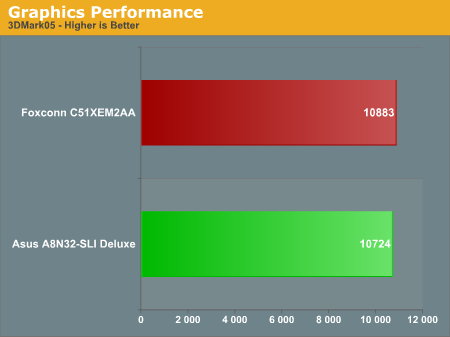
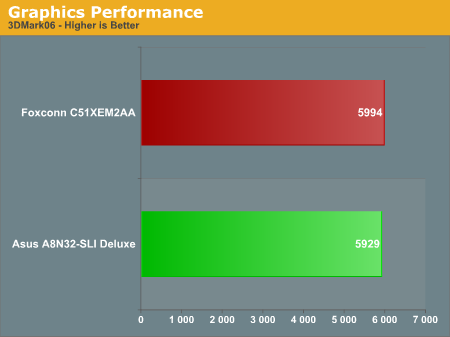
Our nForce 590 SLI system improves upon the performance of the nForce4 system by an average of 1%. These test results are basically a tie and indicates both platforms are performing equally with the same video card.
General System Performance
The PCMark05 benchmark developed and provided by Futuremark was designed for determining overall system performance for the typical home computing user. This tool provides both system and component level benchmarking results utilizing subsets of real world applications or programs. This benchmark is useful for providing comparative results across a broad array of Graphics subsystems, CPU, Hard Disk, and Memory configurations along with multithreading results. In this sense we consider the PCMark benchmark to be both synthetic and real world in nature while providing consistency in our benchmark results.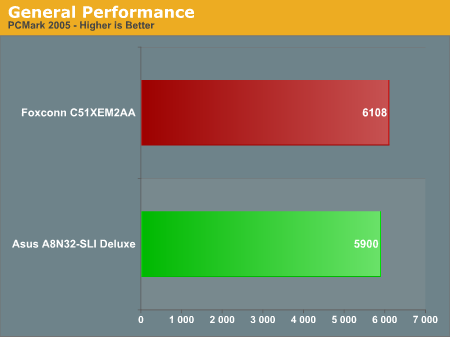
The margins are little wider at 4% in the PCMark05 results, but the margin of error in PCMark05 is also slightly larger. It is obvious from our test results so far that either platform provides excellent results. If you have a socket 939 platform and are happy with its feature set then we do not see a reason to upgrade at this time.
Rendering Performance
We have added the Cinebench 9.5 and POV-RAY 3.6 benchmarks as they heavily stress the CPU subsystem while performing graphics modeling and rendering. We utilize the standard benchmark demos in each program along with the default settings. Cinebench 9.5 features two different benchmarks with one test utilizing a single core and the second test showcasing the power of multiple cores in rendering the benchmark image.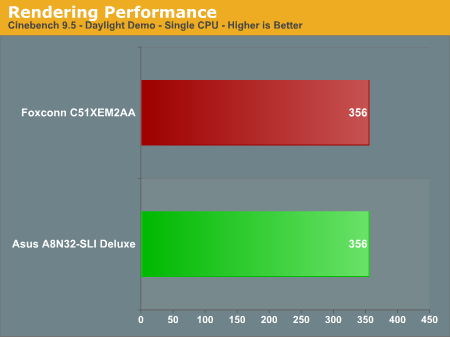

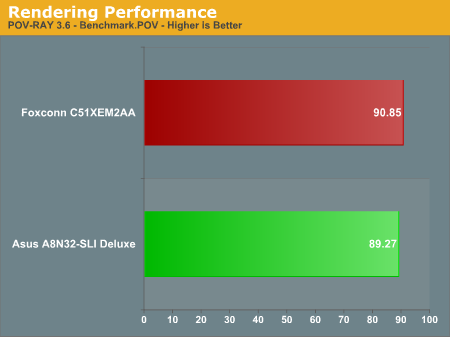
The nForce 500 desktop platform shows small and almost imperceptible differences in these benchmarks, with the 590 AM2 performing slightly better in the demanding POV-RAY benchmark. Once again both platforms are performing equally.










64 Comments
View All Comments
xsilver - Wednesday, May 24, 2006 - link
is there going to be a 5xx nvidia chipset to support conroe?the lack of performance on AM2 makes this chipset highly unexciting
Gary Key - Thursday, May 25, 2006 - link
Yes, it is shaping up to be a very good chipset performance wise with Conroe. ;-)
The main issue with the nf5 chipset actually resides with the AM2 not really being any different than S939 except for the memory controller changes. As in the past, performance will improve once AMD does their memory controller tuning and the bios engineers have more time with the platform. Also, if you could get this board to run at 400fsb with 1:1 memory and 1T being stable, it would be a killer.
Lonyo - Wednesday, May 24, 2006 - link
Is this the same Foxconn board that AMDZone found was poor compared to the Asus NF5 board?http://www.amdzone.com/modules.php?op=modload&...">http://www.amdzone.com/modules.php?op=m...q=viewar...
Gary Key - Wednesday, May 24, 2006 - link
Yes, however, the performance of the Asus board with the latest bios improved scores in certain benchmarks. However, without knowing the bios settings that AMDZone used, it is hard to determine if the new board revision from Asus or bios made a difference. We have already received bios updates for all the boards in our coming roundup.Some have made a slight performance difference, some corrected some early test issues we found. The Foxconn board is a very solid setup and still has improvement potential. We found it to be representative of the initial performance results with the nForce 500. As time goes by and the bios engineers have time to properly tune the boards, we are sure there will be some performance improvements but nothing drastically different from what we are seeing today.